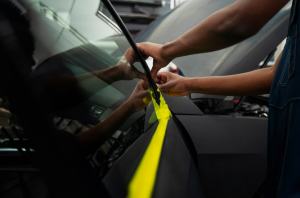Window tints can block up to 99% of harmful ultraviolet (UV) rays, providing significant protection against skin damage and fading of interior furnishings – The Skin Cancer Foundation
For all car owners or enthusiasts, window tint is one of the most common upgrades you look for. If yes, you might come across many tint options available in the market. Whether you should go for ceramic tint, carbon color stable tint, or dyed window film for your vehicle?
To make the best decision, look for the reason behind you getting one. If it’s most likely to block those harmful UV rays then EST Tint & Film should be your go-to option.
Why Do You Need One?
When it comes to choosing window tints, one of the key considerations is UV-ray protection. With the advancement of technology, two popular options have emerged: nano ceramic and traditional window tint. Both options aim to provide UV-ray protection, but they do so in different ways.
In this article, we’ll delve into the differences between nano ceramic and traditional tints, focusing on their effectiveness in safeguarding against harmful UV rays.
Traditional Window Tint – An Affordable Option
Traditional window tints are made using dyed or metallized films. These films work by absorbing or reflecting a portion of the incoming sunlight, including UV rays. Traditional tints are known for their ability to reduce glare, heat, and UV radiation to some extent.
However, traditional tints may not provide as comprehensive UV protection as other advanced options. While they do reduce UV exposure, the degree of protection can vary based on the tint’s composition, quality, and installation. Over time, these tints might experience degradation and become less effective at blocking UV rays.
Nano Ceramic Window Tint – An Advanced Protection
Nano ceramic window tints are a relatively newer and more technologically advanced option. Their composition allows nano ceramic tints to block a higher percentage of UV rays while maintaining optical clarity. These tints are also highly effective in blocking infrared (IR) radiation, which contributes to heat buildup in your vehicle or building.
Nano ceramic tints are renowned for their superior UV protection capabilities. They can block up to 99% of harmful UV rays, providing enhanced defense against skin damage and fading of interior surfaces.
Still Confused?
In terms of UV-ray protection, nano-ceramic window tints have a clear advantage over traditional tints. The ability to block up to 99% of UV rays ensures a higher level of protection for both occupants and interior furnishings.
This is particularly important for individuals who spend extended periods in their vehicles or buildings, as the cumulative effects of UV exposure can be significant.
It’s worth noting that while traditional tints offer some UV protection, their effectiveness can diminish over time due to wear, tear, and exposure to the elements. On the other hand, nano ceramic tints are designed to maintain their UV-blocking capabilities for the long haul.
Make the Right Choice for Your Vehicle
Finally, it’s understood that picking a tint depends on your budget, priorities, and why you are planning to get one. If you prioritize privacy only, regular tint is the one. However, if you are looking for a more advanced solution, ceramic it is.
Whatever you choose, just make sure you pick an authentic service provider. Can’t find one? Connect to EST Tint & Film if you are looking forward to protecting your family and their investment.



